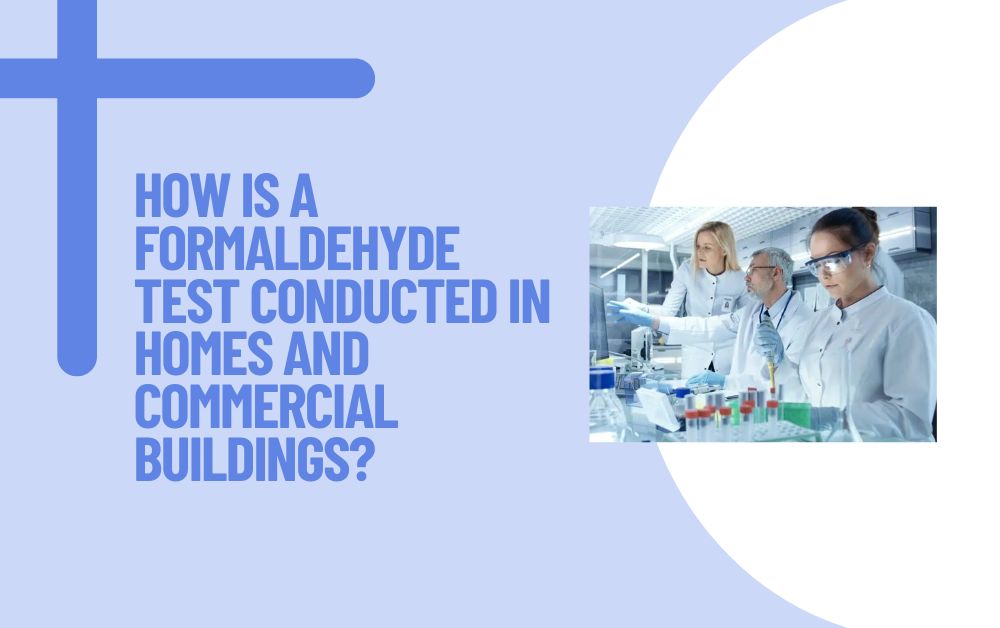Formaldehyde is a common chemical found in many building materials and household products. From the glue in your flooring to the lacquer on your furniture, formaldehyde can be almost everywhere, and it can affect indoor air quality significantly. Because of its potential health risks, testing for formaldehyde levels in homes and commercial buildings is crucial. This blog will guide you through how a formaldehyde test is conducted, explaining each step in simple terms to help you understand the importance and mechanics of the process.
Understanding Formaldehyde
What Is Formaldehyde?
Formaldehyde is a colorless, strong-smelling gas that is used in building materials and many household products. It is known for being a volatile organic compound (VOC), which means it can vaporize and enter the air we breathe. Exposure to formaldehyde can cause a range of health issues, from minor irritations of the eyes, nose, and throat, to more severe effects like respiratory distress and even a risk of cancer in high exposure situations.
Why Test for Formaldehyde?
Testing for formaldehyde in indoor environments is important because it helps ensure that the air quality is safe and healthy. Knowing the levels of formaldehyde can help homeowners and building managers make informed decisions about necessary actions to reduce exposure, such as improving ventilation or replacing certain materials.
The Formaldehyde Testing Process
1. Identifying the Need for Testing
When Should You Test for Formaldehyde?
The need for formaldehyde testing often arises in several scenarios:
- After new construction or remodeling: New materials can off-gas formaldehyde.
- When installing new furniture or flooring: Many manufactured wood products release formaldehyde.
- If occupants experience symptoms: Symptoms like eye irritation, headaches, or respiratory difficulties might prompt a test.
2. Preparing for the Test
How to Get Ready for a Formaldehyde Test
Preparing for a formaldehyde test involves several steps to ensure accurate results:
- Selecting the Right Time: Testing should ideally be conducted under normal living conditions to reflect typical exposure levels.
- Avoiding Disturbances: It’s important to keep windows and doors closed as much as possible 12 hours before and during the testing to stabilize indoor air.
3. Choosing the Testing Method
Different Ways to Test Formaldehyde Levels
There are primarily two methods used to measure formaldehyde in indoor environments:
- Passive Sampling: This method uses a badge or a disk that absorbs formaldehyde from the air over a set period (usually 24 to 48 hours). It’s simple and does not require power.
- Active Sampling: This method involves an air pump that pulls air through a filter or a canister that traps formaldehyde. It is generally more accurate and can provide results in a shorter time.
4. Conducting the Test
Steps in Formaldehyde Testing
- Placement: Devices or samplers are placed in areas where formaldehyde exposure is suspected or where air circulation is representative of the building.
- Duration: The duration of the test can vary depending on the method used but typically ranges from several hours to a couple of days.
- Controlled Environment: Keeping the environment controlled without sudden changes in air flow or temperature during the test period is crucial for accuracy.
5. Analyzing the Results
What Happens After the Test?
Once the testing period is over, the samples are sent to a laboratory where they are analyzed. The lab uses scientific methods to measure the amount of formaldehyde captured by the testing devices.

Interpreting the Findings
- Comparison with Standards: The results are compared to health and safety standards to determine if the formaldehyde levels are within acceptable limits.
- Report: A detailed report is provided, which includes the test results and an assessment of the formaldehyde levels in the tested environment.
6. Taking Action Based on Results
What to Do If Levels Are High?
If formaldehyde levels are higher than recommended:
- Increase Ventilation: Improving air circulation can help reduce formaldehyde concentration.
- Remove or Replace Sources: Identifying and removing or replacing formaldehyde-emitting materials can directly reduce levels.
- Use Air Purifiers: Certain air purifiers are effective at reducing formaldehyde levels in indoor air.
Conclusion
Testing for formaldehyde in homes and commercial buildings is a vital step toward ensuring a safe and healthy environment. By understanding how the test is conducted and interpreting the results accurately, individuals and property managers can take effective measures to control and reduce formaldehyde exposure. Remember, maintaining good indoor air quality is essential for well-being, and managing formaldehyde levels is a crucial part of this process. Whether you are a homeowner, tenant, or building manager, regular testing and proactive measures can help you protect yourself and others from the potential health risks associated with formaldehyde.
Note:- For read more articles visit on repurtech.
